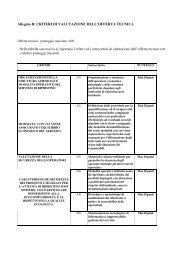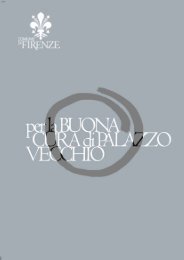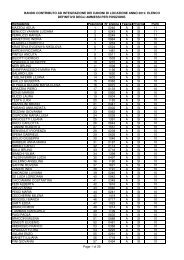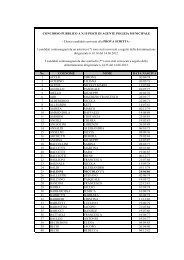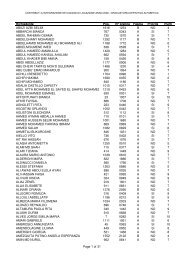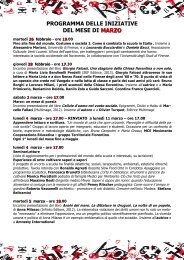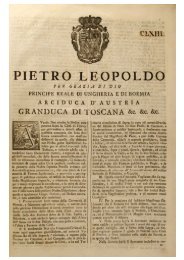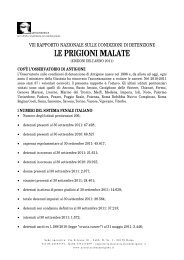Il percorso dei mestieri d'arte - Comune di Firenze
Il percorso dei mestieri d'arte - Comune di Firenze
Il percorso dei mestieri d'arte - Comune di Firenze
Create successful ePaper yourself
Turn your PDF publications into a flip-book with our unique Google optimized e-Paper software.
<strong>Il</strong> <strong>percorso</strong><br />
<strong>dei</strong> <strong>mestieri</strong> d’arte:<br />
artigianato storico fi orentino<br />
A tour of artisan workshops:<br />
the tra<strong>di</strong>tional Florentine crafts
A cura <strong>di</strong> / Written and e<strong>di</strong>ted by<br />
Riccardo Senni - Amalia Giordano<br />
Uffi cio Promozione Economica<br />
Coor<strong>di</strong>namento / Project coor<strong>di</strong>nator<br />
Arianna Guarnieri - Dirigente Servizio Strategie <strong>di</strong> Sviluppo<br />
Hanno collaborato / Contributors<br />
Marta Fallani - Responsabile Uff. Promozione Economica<br />
Progetto grafi co e foto / Graphic design & photo<br />
Mario Mantovani<br />
Traduzione / English translation<br />
J. H. Weiss for Traduco s.a.s. <strong>di</strong> Christine Bulckaen Florence<br />
Responsabile <strong>Comune</strong> Network / <strong>Comune</strong> Network Manager<br />
Maria Siponta De Salvia<br />
Coor<strong>di</strong>namento e<strong>di</strong>toriale <strong>Comune</strong> Network /<br />
<strong>Comune</strong> Network Publishing coor<strong>di</strong>nator<br />
Marta Cavini<br />
Marchio / Logogram<br />
Stu<strong>di</strong>o Curcio<br />
Stampa / Printed by<br />
Litografi a IP <strong>di</strong> Vaggelli Vittorio<br />
In copertina / Cover<br />
Lanifi cium o Tessitura, formella dal basamento<br />
del Campanile <strong>di</strong> S. Maria del Fiore,<br />
attribuita ad Andrea Pisano (1337-48)<br />
<strong>Firenze</strong>, Museo dell’Opera del Duomo<br />
Opera <strong>di</strong> S. Maria del Fiore / Nicolò Orsi Battaglini<br />
Copyright 2008 <strong>Comune</strong> <strong>di</strong> <strong>Firenze</strong><br />
Per informazioni / Further information<br />
www.esercizistorici.it<br />
Si ringraziano i proprietari, gestori<br />
e <strong>di</strong>pendenti degli esercizi storici<br />
per la cortese collaborazione.<br />
We wish to thank the proprietors, managers<br />
and employees of the historic businesses<br />
for their enthusiastic cooperation.<br />
Volume realizzato grazie<br />
al cofi nanziamento della<br />
Regione Toscana
COMUNE DI FIRENZE<br />
Assessorato all’Innovazione e alle Strategie <strong>di</strong> Sviluppo<br />
<strong>Il</strong> <strong>percorso</strong> <strong>dei</strong> <strong>mestieri</strong><br />
d’arte: artigianato<br />
storico fi orentino<br />
A tour of artisan workshops:<br />
the tra<strong>di</strong>tional Florentine crafts.
Underlying the extraor<strong>di</strong>nary economic, political, and<br />
artistic development enjoyed by Florence from the<br />
12th century onward was the fundamental impulse lent by<br />
the craft guilds, the Corporazioni <strong>di</strong> Arti e Mestieri.<br />
By financing a great number of works of art, the guilds<br />
contributed to creating that cultural and artistic fabric<br />
that prepared the city terrain for the flowering of an<br />
incre<strong>di</strong>ble number of great masters. Florence became the<br />
cradle of Humanism and the Renaissance, and as such<br />
played a role of primary importance at the world level.<br />
In an age in which there was no clear <strong>di</strong>stinction between<br />
the arts and the crafts, the workshops or botteghe were<br />
authentic centers of culture. Carvers, decorators,<br />
cabinet-makers, silversmiths, bronze-workers, weavers,<br />
ceramists, tapestry-makers, all of consummate skill and all<br />
with an abi<strong>di</strong>ng love for beauty, created products of total<br />
A tour of artisan workshops:<br />
the tra<strong>di</strong>tional Florentine crafts.<br />
“. . . in Florence . . . I found a <strong>di</strong>fferent nature, permeated<br />
whith the work and thought of man. There, I understood<br />
what a civilization was, and can be. “.<br />
Eugenio Montale.*<br />
excellence that rapidly earned fame at the courts<br />
throughout Europe. Over time, Florence has maintained<br />
its role as guide in the crafts sector; and it is this<br />
production - together with the city’s immense artistic<br />
heritage - that has formed the city’s unique, unmistakable<br />
character. This publication proposes an itinerary to help<br />
us re<strong>di</strong>scover the best of the Florentine crafts tra<strong>di</strong>tion at<br />
workshops that have handed down their “know-how” from<br />
generation to generation and by so doing have played an<br />
invaluable part in conserving a legacy of ready invention<br />
and ingenuity that more than merits attention.<br />
*) Interview with Eugenio Montale, cited in Betocchi, Silvia Gli anni <strong>di</strong><br />
Montale al Gabinetto Vieusseux <strong>di</strong> <strong>Firenze</strong>, in Italica, vol. 71, no. 3, Fall<br />
(1994), pp. 311-324, from Eugenio Montale Tutte le opere (ed. Giacinto<br />
Spagnoletti) Milano, Bruno Mondadori E<strong>di</strong>tore, 1978.
Alla base dello straor<strong>di</strong>nario sviluppo economico,<br />
politico e artistico che <strong>Firenze</strong> visse a partire dal XII<br />
secolo, vi è il fondamentale impulso dato dalle<br />
Corporazioni <strong>di</strong> Arti e Mestieri. Queste, finanziando<br />
molte opere d’arte, contribuirono a creare quel tessuto<br />
culturale e artistico che vide fiorire in città una<br />
concentrazione altissima <strong>di</strong> gran<strong>di</strong> maestri. <strong>Firenze</strong><br />
<strong>di</strong>ventò la culla dell’Umanesimo e del Rinascimento assumendo<br />
un ruolo <strong>di</strong> primaria importanza nel mondo.<br />
In un’epoca in cui non vi era una netta <strong>di</strong>stinzione tra arte<br />
e artigianato, le botteghe rappresentavano degli<br />
autentici centri <strong>di</strong> cultura. Intagliatori, decoratori,<br />
ebanisti, argentieri, bronzisti, tessitori, ceramisti,<br />
arazzieri, tutti dotati <strong>di</strong> abilità tecniche e <strong>di</strong> amore per la<br />
bellezza dettero origine a manufatti d’eccellenza famosi<br />
presso le corti <strong>di</strong> tutta Europa.<br />
<strong>Il</strong> <strong>percorso</strong> <strong>dei</strong> <strong>mestieri</strong> d’arte:<br />
artigianato storico fi orentino.<br />
“…a <strong>Firenze</strong> …ho trovato una natura compenetrata nel<br />
lavoro e nel pensiero dell’uomo. Vi ho compreso che cosa è<br />
stata, che cosa può essere una civiltà “.<br />
Eugenio Montale.*<br />
<strong>Firenze</strong> ha mantenuto nel tempo il ruolo <strong>di</strong> guida nel<br />
settore dell’artigianato, che rappresenta, insieme al suo<br />
immenso patrimonio artistico, il suo carattere unico e<br />
inconfon<strong>di</strong>bile.<br />
Questo opuscolo propone un <strong>percorso</strong> per ritrovare la<br />
migliore tra<strong>di</strong>zione artigianale fiorentina presso quelle<br />
botteghe che, tramandando il “saper fare” <strong>di</strong> generazione<br />
in generazione, ci hanno saputo consegnare un patrimonio<br />
<strong>di</strong> ingegno umano che necessita <strong>di</strong> essere conosciuto.<br />
*) Intervista con Eugenio Montale, citata in Betocchi, Silvia Gli anni <strong>di</strong><br />
Montale al Gabinetto Vieusseux <strong>di</strong> <strong>Firenze</strong>, in Italica, vol. 71, no. 3, Fall<br />
(1994), pp. 311-324, da Eugenio Montale, Tutte le opere (ed. Giacinto<br />
Spagnoletti) Milano, Bruno Mondadori E<strong>di</strong>tore, 1978.
14<br />
3<br />
8<br />
19<br />
11<br />
21<br />
6<br />
20<br />
STAZIONE<br />
S. MARIA<br />
NOVELLA<br />
PITTI<br />
S. LORENZO<br />
12<br />
DUOMO<br />
S. CROCE<br />
7 UFFIZI<br />
S. SPIRITO 9 12<br />
4<br />
18<br />
15<br />
1<br />
10<br />
16<br />
23<br />
17<br />
22<br />
2<br />
13<br />
5<br />
1. Bartolozzi e Maioli<br />
2. Campani Cornici<br />
3. Sernissi Massimiliano<br />
4. Bini Forme per Cappelli<br />
5. Filistrucchi<br />
6. Bronzista Bal<strong>di</strong>ni<br />
7. Duccio Banchi<br />
8. F.lli Ugolini Bronzisti<br />
9. Ugolini Calderaio<br />
10. Paolo Pagliai Argentiere<br />
11. Bruscoli Pelletteria-Legatoria<br />
12. Scuola del Cuoio<br />
13. Sbigoli Terrecotte<br />
14. Locchi<br />
15. Antica Tappezzeria Borsellini<br />
16. Giulio Giannini & Figlio<br />
17. Legatoria Legatoria Balsimelli<br />
18. Liverano<br />
19. Tessilarte<br />
20. Piumaccio d’Oro<br />
21. Gestione Picchiani & Barlacchi<br />
22. Puliti<br />
23. Mannina
Affacciandosi nella bottega d’arte <strong>di</strong> Bartolozzi<br />
e Maioli, ubicata dal 1938 nel centro storico<br />
artigianale dell’Oltrarno, o visitando il magazzino<br />
nella vicina Via <strong>dei</strong> Vellutini 5r, sembra <strong>di</strong> entrare<br />
in un vero e proprio museo. Settanta anni <strong>di</strong> intensa<br />
attività hanno contribuito a collezionare un numero<br />
considerevole <strong>di</strong> reperti, modelli e prototipi, ancor<br />
oggi usati per la produzione <strong>di</strong> oggetti lignei a<br />
intaglio, <strong>di</strong>stribuiti in tutto il mondo.<br />
La Bartolozzi e Maioli ha lavorato fra l’altro al<br />
restauro dell’Abbazia <strong>di</strong> Montecassino, agli arre<strong>di</strong> per<br />
il Palazzo del Quirinale, per le residenze del Sultano<br />
degli Emirati Arabi e al rifacimento <strong>di</strong> due sale del<br />
Cremlino.<br />
When you peek into the Bartolozzi e Maioli store<br />
that has been located in the historic<br />
Oltrarno artisans’ <strong>di</strong>strict since 1938, or enter the<br />
warehouse in nearby Via <strong>dei</strong> Vellutini 5r, it feels like<br />
touring a museum. Seventy years of intensive work<br />
have contributed to the collection of a remarkable<br />
quantity of antiques, models and prototypes that are still used today<br />
to make carved wooden items which are sold throughout the world.<br />
Bartolozzi e Maioli have also worked on the restoration of the Abbey<br />
of Montecassino, furnishings in the Palazzo del Quirinale, the<br />
residences of the Sultan of the Arab Emirates, and the restoration of<br />
two rooms in the Kremlin.<br />
Bartolozzi e Maioli<br />
Bartolozzi e Maioli<br />
Via Maggio, 13r<br />
Via <strong>dei</strong> Vellutini, 5r<br />
tel. 055 2398633<br />
7
8<br />
Campani Cornici<br />
Campani Cornici<br />
Via <strong>dei</strong> Servi, 22r<br />
tel. 055 216984<br />
F<br />
in dal 1889 la <strong>di</strong>tta Campani si è de<strong>di</strong>cata alla<br />
produzione artigiana <strong>di</strong> cornici per <strong>di</strong>pinti, foto<br />
e stampe con vari tipi <strong>di</strong> passe-partout.<br />
<strong>Il</strong> fondatore della <strong>di</strong>tta, Gino Campani, era<br />
conosciuto in <strong>Firenze</strong> come il corniciaio <strong>di</strong> fi ducia<br />
<strong>di</strong> molti artisti, dai post-macchiaioli al giovane Annigoni,<br />
<strong>dei</strong> quali <strong>di</strong>venne anche un collezionista.<br />
I locali, che in passato erano annessi alla Chiesa <strong>di</strong><br />
S. Michele Visdomini, purtroppo non conservano<br />
più gli arre<strong>di</strong> originali che andarono perduti con<br />
l’Alluvione del 1966 (l’acqua in questo punto arrivò<br />
all’altezza <strong>di</strong> metri 2,30).<br />
Since 1889 Campani have been de<strong>di</strong>cated to<br />
making handcrafted frames and mats for<br />
paintings, photographs and prints.<br />
The founder, Gino Campani, was known throughout<br />
the city as the trusted framer of many artists, from<br />
the post-Macchiaioli to the then young Annigoni,<br />
and in fact, became also a collector of their works.<br />
The premises, that were once attached to the<br />
Church of San Michele Visdomini lost their<br />
original furnishings during the <strong>di</strong>sastrous fl ood of<br />
1966 (the water reached a height of 2.30 meters,<br />
that is over 7.5 feet!).
Nel 1954 Fabio Bucciarelli avviò una bottega<br />
Nper<br />
il restauro e le imitazioni <strong>di</strong> cornici antiche.<br />
Come appren<strong>di</strong>sta iniziò a lavorarvi Massimiliano<br />
Sernissi che, all’inizio degli anni ‘80, ne assunse la<br />
conduzione. A tutt’oggi Massimiliano Sernissi, detto<br />
“Leone” per il suo carattere orgoglioso e grintoso,<br />
con la collaborazione delle fi glie Simona e Valentina,<br />
esercita con passione e bravura l’attività <strong>di</strong><br />
restauratore <strong>di</strong> cornici; la sua abilità si manifesta<br />
anche nel restauro <strong>dei</strong> tabernacoli e <strong>dei</strong> fon<strong>di</strong> oro <strong>dei</strong><br />
<strong>di</strong>pinti antichi.<br />
In questa bottega si realizzano cornici in ogni stile<br />
e Sernissi ha lavorato per alcuni <strong>dei</strong> maggiori musei<br />
del mondo incorniciando anche <strong>di</strong>pinti <strong>di</strong> Pollock e<br />
Moran<strong>di</strong>.<br />
In 1954 Fabio Bucciarelli opened a workshop<br />
where he restored – and reproduced – antique<br />
frames. His young apprentice, Massimiliano Sernissi<br />
took over the business in the early 1980s.<br />
Today, Massimiliano Sernissi, known as Leone – “the<br />
lion” – for his strong, proud character works with his daughters Simona<br />
and Valentina, restoring antique frames. However, their passion and skill<br />
extend to the restoration of tabernacles and the gold grounds of antique<br />
paintings. The Sernissi workshop makes picture frames in all styles, and<br />
has worked for some of the world’s major museums framing paintings by<br />
Pollock, Moran<strong>di</strong> and other renowned artists.<br />
Sernissi Massimiliano<br />
Sernissi Massimiliano<br />
Via il Prato, 46r<br />
tel. 055 282090<br />
9
10<br />
Bini Forme per Cappelli<br />
Bini Forme per Cappelli<br />
Piazza S. Spirito, 5r<br />
tel. 055 282292<br />
F<br />
ondata nel 1887, la sede originale dell’attività<br />
si trovava in Mercato Vecchio, poi poi abbandonata<br />
quando la zona fu ristrutturata ra<strong>di</strong>calmente per<br />
farne il nuovo centro <strong>di</strong> <strong>Firenze</strong> (piazza della<br />
Repubblica). L’attività tra<strong>di</strong>zionale consiste nella<br />
produzione <strong>di</strong> calchi in legno per la realizzazione <strong>di</strong><br />
parrucche e copricapo, spesso destinati a personaggi<br />
importanti. Inoltre si creano oggetti per<br />
rappresentazioni teatrali e riprese cinematografi che<br />
in collaborazione con costumisti e scenografi .<br />
Tutte le lavorazioni vengono eseguite, con sgorbie<br />
e scalpelli, su banconi da lavoro e banchetti per<br />
scultura datati 1925. Oggi la <strong>di</strong>tta Bini ha ampliato<br />
l’assortimento offrendo anche oggetti decorativi in<br />
legno.<br />
When it was fi rst opened in 1887, this shop was<br />
located in the Mercato Vecchio that was torn<br />
down to build the new city center – what is now<br />
Piazza della Repubblica. The fi rm’s tra<strong>di</strong>tional<br />
business is that of making wooden forms for hats<br />
and wigs – often for celebrities. In ad<strong>di</strong>tion, the product range<br />
includes items for theater and cinema and they are made in<br />
cooperation with costume and scenery designers.<br />
All the work is done on tra<strong>di</strong>tional benches, from 1925, using<br />
gouges and chisels. Today, the shop has expanded the production<br />
to include a range of wooden gift items.
Fondata nel 1720, la <strong>di</strong>tta Filistrucchi è la più<br />
Fantica<br />
bottega <strong>di</strong> <strong>Firenze</strong> a tra<strong>di</strong>zione familiare.<br />
Specializzata in trucchi e parrucche, ha<br />
collaborato con stu<strong>di</strong> cinematografi ci e televisivi,<br />
con teatri e compagnie, dalla Scala al Metropolitan<br />
e servito clienti come Maria Callas e Luciano<br />
Pavarotti.<br />
Filistrucchi, che possiede una delle biblioteche più<br />
complete del settore, riproduce vari tipi <strong>di</strong> parrucche<br />
d’epoca e parrucche per bambole antiche, operando<br />
per musei, antiquari e restauratori.<br />
Filistrucchi realizza anche parrucche e posticci per<br />
tricolesi, mentre l’esperienza della bottega si<br />
trasmette attraverso le riviste specializzate e le<br />
scuole <strong>di</strong> trucco.<br />
Founded in 1720, Filistrucchi is the oldest familyoperated<br />
business in Florence.<br />
Specializing in wigs and makeup, they have worked<br />
with fi lm and television stu<strong>di</strong>os, theaters and opera<br />
houses, from La Scala to the Metropolitan Opera and<br />
their list of customers includes names such as Maria Callas and Luciano Pavarotti.<br />
Filistrucchi, own one of the most complete specialized libraries.<br />
They make <strong>di</strong>fferent types of period wigs, as well as wigs for antique dolls, provide<br />
their services to museums, antiques dealers and restorers, and make modern wigs<br />
and toupees for people suffering from hair loss. Trade magazine and makeup schools<br />
help carry on the great Filistrucchi tra<strong>di</strong>tions.<br />
Filistrucchi<br />
Filistrucchi<br />
Via Ver<strong>di</strong>, 9<br />
tel. 055 2344901<br />
11
12<br />
Bronzista Bal<strong>di</strong>ni<br />
Bronzista Bal<strong>di</strong>ni<br />
Via Palazzuolo, 101r<br />
tel. 055 210933<br />
A<br />
partire dal 1918, quando iniziò la sua attività<br />
<strong>di</strong> bronzista, Ubaldo Bal<strong>di</strong>ni conservò il<br />
modello <strong>di</strong> ogni pezzo riprodotto o riparato per<br />
conto <strong>di</strong> nobili, antiquari e collezionisti. Grazie a<br />
lui la <strong>di</strong>tta gestisce oggi una collezione <strong>di</strong> migliaia <strong>di</strong><br />
oggetti (pomelli, maniglie, borchie, …) che<br />
vengono riprodotti con la tra<strong>di</strong>zionale fusione a<br />
staffa.<br />
L’attività della <strong>di</strong>tta Bal<strong>di</strong>ni comprende anche la<br />
produzione <strong>di</strong> accessori per il bagno, lucerne,<br />
lampade da tavolo e da terra, montature per tende e<br />
la realizzazione <strong>di</strong> oggetti su <strong>di</strong>segno del<br />
committente.<br />
Starting in 1918 when he began working in<br />
bronze, Ulbaldo Bal<strong>di</strong>ni kept the models of<br />
every single item he reproduced or repaired for<br />
nobles, antiques dealers and collectors. Thanks to<br />
his foresight, the fi rm now has a collection of thousands<br />
of items (knobs, handles, bosses, …) that are<br />
reproduced using tra<strong>di</strong>tional casting fl asks.<br />
Bal<strong>di</strong>ni also make bathroom accessories, lanterns,<br />
table and fl oor lamps, curtain rods and customdesigned<br />
items.
Questo mestiere artigiano si è trasmesso da<br />
Q Qmaestro<br />
ad allievo, a partire dalla fi ne dell’800,<br />
quando a Giovanni Stanghi, detto Leprino, successe<br />
Emilio Ercolani e a lui Vasco Cappuccini che, nel<br />
1925 aprì questo laboratorio, dove si conservano<br />
ancora gli arre<strong>di</strong> originali.<br />
Dal 1946 Lamberto Banchi, unico allievo <strong>di</strong><br />
Cappuccini, inizia a specializzarsi in riproduzioni<br />
artistiche, in bronzi per mobili e porte ed in cornici per<br />
foto in varie fogge e stili.<br />
Oggi l’attività è condotta da Duccio che, formatosi alla<br />
bottega del padre e specializzatosi con Giorgio Piazzini<br />
e Bino Bini, esegue ancora la tra<strong>di</strong>zionale fusione a<br />
staffa o a cera persa e la rifi nitura al cesello.<br />
This craft has been handed down from master to<br />
apprentice since the late 19th century: Giovanni<br />
Stanghi, known as Leprino, turned the business over to<br />
Emilio Ercolani, who was succeeded by Vasco<br />
Cappuccini who, in 1925 opened this workshop that<br />
still has its original furnishings.<br />
In 1946 Lamberto Banchi, Cappuccini’s only pupil, began to specialize<br />
in artistic bronze reproductions for furniture and doors, photo frames in<br />
<strong>di</strong>fferent styles. Today it is Duccio who runs the business. He learned the<br />
craft in his father’s workshop, and then went on to hone his skills with<br />
Giorgio Piazzini and Bino Bini; even today he uses the tra<strong>di</strong>tional sand<br />
and lost wax casting methods and cold-fi nishes each piece by hand.<br />
Duccio Banchi<br />
Duccio Banchi<br />
Via <strong>dei</strong> Serragli, 10r<br />
tel. 055 294694<br />
13
14<br />
F.lli Ugolini Bronzisti<br />
F.lli Ugolini Bronzisti<br />
Via del Drago d’oro, 25r<br />
tel. 055 215343<br />
R<br />
affaello Ugolini dette il via all’attività sul fi nire<br />
dell’800, gli successe successe poi poi il il fi glio glio Guido Guido che che<br />
allestì il laboratorio nell’abitazione al numero 9 <strong>di</strong><br />
Via del Drago d’Oro. Qui Guido riparava oggetti<br />
d’arte in bronzo e ottone, cesellava e creava modelli<br />
originali per maniglie e candelabri ampliando il<br />
laboratorio fi no all’impianto della nuova fonderia.<br />
Conduce oggi l’attività Paola, nipote <strong>di</strong> Guido, che<br />
ha notevolmente esteso la gamma <strong>dei</strong> prodotti, dai<br />
complementi d’illuminazione e <strong>di</strong> arredo alle basi per<br />
lampade, dai piccoli tavoli coi piani in marmo<br />
intarsiato alle maniglie per porte e mobili in ogni<br />
stile. La lavorazione è interamente eseguita a mano,<br />
dalla fusione alla cesellatura.<br />
Raffaello Ugolini started this business at the<br />
end of the 19th century, and was succeeded<br />
by his son, Guido who set up the workshop in the<br />
family home at Via del Drago d’Oro 9. There Guido<br />
repaired bronze and brass items, graved and created<br />
original models for handles and candelabra and kept<br />
on expan<strong>di</strong>ng the workshop until he set up the new foundry.<br />
Today it is Paola, Guido’s granddaughter who runs the business.<br />
She has expanded the product range so that it now includes<br />
lighting and furnishing accessories, lamp bases, occasional tables<br />
with inlaid marble tops, door knobs and furniture in all styles.<br />
All the work is done entirely by hand, from casting to chasing.
Sergio Ugolini, dopo aver imparato il mestiere<br />
Snella<br />
bottega del padre e del bisnonno Raffaello,<br />
nel 1950 decise <strong>di</strong> avviare un nuovo laboratorio<br />
in via del Presto <strong>di</strong> S. Martino ad un passo dalla<br />
Chiesa <strong>di</strong> S. Spirito, uno <strong>dei</strong> fulcri dell’operosa zona<br />
dell’ Oltrarno.<br />
Se inizialmente il lavoro consisteva principalmente<br />
nel restauro <strong>di</strong> oggetti antichi o <strong>di</strong> strumenti <strong>di</strong> uso<br />
comune, oggi l’attività principale è quella <strong>di</strong><br />
bronzista e <strong>di</strong> tiratura a mano <strong>di</strong> lamine <strong>di</strong> rame.<br />
In questo ormai storico laboratorio vengono<br />
realizzati oggetti artistici <strong>di</strong> alta qualità, come vasi<br />
e bacili realizzati a sbalzo, con un occhio <strong>di</strong><br />
particolare riguardo ai modelli antichi.<br />
After having learned the trade from his father<br />
and Raffaello, his great-grandfather, in 1950<br />
Sergio Ugolini decided to open a new workshop in<br />
Via del Presto <strong>di</strong> S. Martino just a stone’s throw<br />
from the church of Santo Spirito, one of the key<br />
points in the busy Oltrarno <strong>di</strong>strict.<br />
If, in the early days, he mainly restored antiques or<br />
commonplace items, today he specializes in bronze<br />
and hand-drawn copper. This workshop, a piece of<br />
living history, turns out high quality artistic wares<br />
such as hammered vases and bowls, with a special<br />
eye focused on antique models.<br />
Ugolini Calderaio<br />
Ugolini Calderaio<br />
Via del Presto<br />
<strong>di</strong> S. Martino, 23r<br />
tel. 055 287230<br />
15
16<br />
Paolo Pagliai Argentiere<br />
Paolo Pagliai Argentiere<br />
Borgo San Jacopo, 41r<br />
tel. 055 282840<br />
O<br />
rlando Pagliai iniziò l’attività <strong>di</strong> argentiere<br />
restauratore nel nel 1930 e, nel nel 1980 il fi glio<br />
Paolo si è trasferito nella me<strong>di</strong>evale torre <strong>dei</strong> Sapiti,<br />
<strong>di</strong> fronte alla chiesa <strong>di</strong> San Jacopo Soprarno.<br />
<strong>Il</strong> laboratorio <strong>di</strong> Paolo Pagliai è un punto <strong>di</strong><br />
riferimento per antiquari e collezionisti che gli<br />
chiedono <strong>di</strong> ricostruire parti mancanti <strong>di</strong> preziosi<br />
oggetti <strong>di</strong> antiquariato o <strong>di</strong> riprodurre posateria<br />
antica con fusioni in terra refrattaria.<br />
Per i numerosi e affezionati clienti <strong>di</strong> tutt’Italia è<br />
ugualmente importante la produzione degli oggetti<br />
fi rmati Pagliai, creati con le antiche tecniche <strong>di</strong><br />
lavorazione.<br />
Orlando Pagliai began working as a silversmithrestorer<br />
in 1930; in 1980 his son Paolo<br />
moved the business to the Me<strong>di</strong>eval Sapiti tower<br />
opposite the church of San Jacopino Soprarno.<br />
Paolo Pagliai’s workshop is a reference point for<br />
antiques dealers and collectors. They turn to him<br />
for reconstructions of missing parts of valuable<br />
antiques or for reproductions of antique fl atware<br />
that he makes with tra<strong>di</strong>tional casting methods.<br />
In ad<strong>di</strong>tion, Pagliai has gained a large following<br />
among clients worldwide with his own, signed<br />
objects – that are always made with the old methods.
Bruscoli Pelletteria-Legatoria<br />
E<br />
gisto Bruscoli aprì la tipografi a e legatoria nel<br />
E 1881, nel nel 1904 fu premiato per una rilegatura<br />
artistica della<br />
Divina Comme<strong>di</strong>a. . <strong>Il</strong> fi glio e i nipoti si<br />
concentrarono sulla legatoria d’arte e il restauro <strong>di</strong><br />
libri. Nel 1958 Paolo Bruscoli iniziò il restauro <strong>dei</strong><br />
preziosi volumi della Biblioteca Laurenziana.<br />
L’alluvione del 1966, che colpì duramente il negozio,<br />
non scoraggiò i fratelli Bruscoli che furono<br />
presto coinvolti nel restauro delle raccolte della<br />
Biblioteca Nazionale.<br />
Ginevra Bruscoli (siamo alla 5a generazione)<br />
mantiene le antiche tecniche <strong>di</strong> lavorazione nella<br />
legatoria d’arte, nel restauro <strong>di</strong> libri, nel rifacimento<br />
<strong>dei</strong> cuoi artistici per poltrone, scrivanie e nella<br />
produzione artigianale <strong>di</strong> vari articoli <strong>di</strong> pelletteria.<br />
Egisto Bruscoli opened his printing and<br />
bookbin<strong>di</strong>ng shop in 1881: in 1904, he won an<br />
award for an artistic bin<strong>di</strong>ng of the Divine Comedy.<br />
His son and grandchildren devoted themselves to<br />
bookbin<strong>di</strong>ng and restorations. In 1958 Paolo<br />
Bruscoli began restoring the priceless volumes in the Biblioteca Laurenziana here<br />
in Florence. The 1966 fl ood severely damaged the shop, but <strong>di</strong>d not <strong>di</strong>scourage<br />
the Bruscoli brothers who were soon hard at work restoring the collections in the<br />
Biblioteca Nazionale. Ginevra Bruscoli (we are now in the 5th generation) still<br />
uses the tra<strong>di</strong>tional methods for artistic bookbin<strong>di</strong>ngs, restoring books, artistic<br />
leather work for chairs and desks, and in the production of artistic leather goods.<br />
Bruscoli Pelletteria-Legatoria<br />
Via Montebello, 58r<br />
tel. 055 212947<br />
17
18<br />
Scuola del Cuoio<br />
Scuola del Cuoio<br />
Via S. Giuseppe, 5r<br />
Piazza S. Croce, 16<br />
tel. 055 244533<br />
L<br />
a Scuola è nata nel dopoguerra dall’incontro tra<br />
i Frati Francescani <strong>di</strong> Santa Croce e e la famiglia<br />
Gori, pellettieri fi orentini dal 1930. I primi allievi<br />
furono gli orfani <strong>di</strong> guerra e i giovani <strong>dei</strong> quartieri più<br />
poveri. Oggi i corsi della Scuola sono aperti a italiani<br />
e stranieri ed offrono borse <strong>di</strong> stu<strong>di</strong>o per i giovani<br />
più bisognosi. Vi si possono acquistare borse, piccola<br />
pelletteria, scrittoi, portagioie e vari oggetti in cuoio<br />
lavorato. Francesca Gori <strong>di</strong>segna inoltre borse cucite a<br />
mano, pezzi unici realizzati in pelli rare e decorati con<br />
pietre, gioielli etnici ed argenti antichi.<br />
La Scuola del Cuoio propone anche brevi “immersioni”<br />
nell’artigianato della pelle per chi vuol respirare<br />
l’atmosfera <strong>di</strong> una vera bottega fi orentina.<br />
The Scuola del Cuoio (leather school) was the child<br />
of post-World War II cooperation between the<br />
Friars of Santa Croce and the Gori family, leather<br />
crafters in Florence since 1930. The fi rst pupils<br />
were war orphans and youths from the city’s poorest<br />
neighborhoods. Today, the school offers courses to<br />
Italians and foreigners, along with scholarships for the nee<strong>di</strong>est students.The Scuola<br />
sells handbags, small leather goods, desk sets, jewel boxes and various tooled leather<br />
items. Francesca Gori designs handbags that are hand-sewn – each one is unique,<br />
made of rare hides and decorated with stones, ethnic jewels and antique silver.<br />
The Scuola also offers brief “immersions” into the art of leather-crafting for those<br />
who want to experience the atmosphere of a true Florentine workshop.
L<br />
’attività iniziò nel 1850 in S. Ambrogio,<br />
Lvendendo<br />
laterizi, stufe e vasi; negli anni ‘20 fu<br />
trasferita negli attuali locali, ampliando l’assortimento<br />
con tegami <strong>di</strong> terracotta e ceramiche. Dopo i gravi<br />
danni subiti con l’Alluvione del 1966, il negozio fu<br />
rilevato da Valentino e Antonella Adami che<br />
vi installarono un laboratorio per la produzione <strong>di</strong><br />
ceramiche da tavola e piatti da muro. Antonella Chini<br />
Adami, <strong>di</strong>scendente dalla nota famiglia <strong>di</strong> ceramisti<br />
(i Chini) e la fi glia Lorenza, specializzata in tornitura e<br />
in decorazione, proseguono la tra<strong>di</strong>zione con <strong>di</strong>segni<br />
nuovi ed originali sviluppati sugli antichi stilemi.<br />
Sbigoli organizza anche corsi <strong>di</strong> ceramica, tornio e<br />
decorazione a vari livelli.<br />
This business was fi rst opened in 1850 in the S.<br />
Ambrogio neighborhood and dealt mainly in<br />
buil<strong>di</strong>ng supplies, terracotta stoves and fl ower pots.<br />
Sometime around 1920 it was moved to its current<br />
location and the product range was expanded to<br />
include terracotta cookware and ceramics. After the<br />
severe damage caused by the 1966 fl ood, Valentino and Antonella Adami took over the<br />
business, installed a workshop and kiln to make tableware and wall decorations. Antonella<br />
Chini Adami (a descendant of the renowned Chini family of ceramists) and her daughter<br />
Lorenza, specialized in working at a potter’s wheel and painting decorations, are continuing<br />
the tra<strong>di</strong>tion as well as developing new, original patterns based on old models.<br />
Sbigoli also offers ceramics courses, for students at various levels of profi ciency.<br />
Sbigoli Terrecotte<br />
Sbigoli Terrecotte<br />
Via S. Egi<strong>di</strong>o, 4r<br />
tel. 055 2479713<br />
19
20<br />
Locchi<br />
Locchi<br />
Via Burchiello, 10<br />
tel. 055 2298371<br />
I<br />
l laboratorio <strong>di</strong> moleria “Mariani”, situato in via<br />
dell’Orto, <strong>di</strong>venne <strong>di</strong>venne “Mariani e Locchi” negli anni<br />
‘20 con l’ingresso <strong>di</strong> Italo Locchi. Inizialmente<br />
produceva serviti <strong>di</strong> bicchieri molati ed incisi per<br />
gran<strong>di</strong> alberghi e navi da crociera, poi si rivolse ai<br />
privati, riproducendo modelli presi dai serviti della<br />
nobiltà fi orentina, per i quali realizzava pezzi <strong>di</strong><br />
sostituzione. Uscito il fondatore Mariani, nel 1955<br />
il laboratorio si trasferì nella sede attuale.<br />
Nel 1964, dopo la morte <strong>di</strong> Italo, la nuora Paola<br />
Vannoni Locchi subentrò nella <strong>di</strong>rezione, che<br />
mantiene ancora oggi, coa<strong>di</strong>uvata dalla nuora<br />
Giovanna e da 4 bravissimi molatori.<br />
The “Mariani” crystal cutting workshop in Via<br />
dell’Orto, became “Mariani e Locchi” in the<br />
1920s when Italo Locchi joined the business.<br />
Initially the fi rm made cut and engraved glassware<br />
for the grand hotels and ocean liners, then it turned<br />
to a private clientele, reproducing models and<br />
making replacement pieces for the grand services<br />
used by the Florentine nobility. When the founder Mariani<br />
retired, the workshop was transferred to its current location in<br />
1955. Upon Italo’s death in 1964, his daughter-in-law Paola<br />
Vannoni Locchi, had to take over and she manages the business<br />
even today, with her daughter-in-law, Giovanna, and four<br />
outstan<strong>di</strong>ng artisans.
Antica Tappezzeria Borsellini<br />
N<br />
el 1890 Alfonso Borsellini aprì una bottega<br />
Nper<br />
per il il restauro <strong>di</strong> arazzi, oggetti in tessuto e la<br />
realizzazione <strong>di</strong> <strong>di</strong>vani, poltrone e tendaggi.<br />
I locali risalgono al ‘400, con pavimenti in cotto e<br />
soffi tti a cassettoni lignei.<br />
Ancora oggi Alberto e Luca Borsellini (padre e fi glio)<br />
conservano la tra<strong>di</strong>zione artigiana della tappezzeria,<br />
lavorando quasi esclusivamente a mano per prodotti<br />
eseguiti su <strong>di</strong>segno o seguendo le semplici intuizioni<br />
del cliente. La tappezzeria restaura pelli, cuoi e tessuti<br />
antichi, con una tecnica sperimentata. Si restaurano<br />
anche arazzi antichi, ricostruendo la trama mancante<br />
o la fi gura, con colori identici e lo stesso tipo <strong>di</strong> fi lato<br />
in lana o seta.<br />
In 1890 Alfonso Borsellini opened a workshop<br />
where he restored tapestries and textiles and<br />
made sofas, armchairs and draperies. The premises<br />
date back to the 15th century, with cotto fl oors and<br />
coffered wooden ceilings.<br />
Today, Alberto and Luca Borsellini (father and son)<br />
are carrying on the tra<strong>di</strong>tions: they work almost exclusively by<br />
hand making items to specifi c designs or simply understan<strong>di</strong>ng<br />
their clients’ wishes. The workshop restores antique textiles and<br />
leathers using a time-tested technique. They also restore antique<br />
tapestries reconstructing the missing warp or pattern using<br />
identical color and quality – wool or silk – yarns and threads.<br />
Antica Tappezzeria Borsellini<br />
Via Maggio, 54r<br />
tel. 055 212051<br />
21
22<br />
Giulio Giannini & Figlio - Bottega d’Arte<br />
Giulio Giannini & Figlio<br />
Bottega d’Arte<br />
Piazza <strong>dei</strong> Pitti, 37r<br />
tel. 055 212621<br />
L<br />
a cartoleria aperta nel 1856 da Pietro Giannini,<br />
ebbe nel fi glio Giulio il vero promotore<br />
della rilegatura artigianale: ricostruì gli stili del<br />
Rinascimento e ne creò <strong>di</strong> nuovi combinando<br />
elementi antichi; scrisse sulle rilegature e l’arte della<br />
stampa, fu e<strong>di</strong>tore e stampatore e fece realizzare una<br />
gran quantità <strong>di</strong> punzoni, avviando una collezione<br />
oggi arrivata a 3000 pezzi.<br />
Suo fi glio Giulio Jr fu anche illustratore e pittore,<br />
mentre i nipoti Enrico e Guido continuano le attività<br />
tra<strong>di</strong>zionali, alle quali si affi anca la creazione delle<br />
carte fantasia e <strong>di</strong> quelle eseguite a mano con la<br />
tecnica “a bagno” originale del Seicento.<br />
Pietro Giannini started this business in 1856,<br />
but it was his son, Giulio, who truly devoted<br />
himself to fi ne bookbin<strong>di</strong>ngs. He brought back<br />
the Renaissance styles and created new ones by<br />
combining tra<strong>di</strong>tional elements and techniques.<br />
He wrote books about bookbin<strong>di</strong>ng and the art<br />
of printing, he was a publisher and printer and<br />
designed a huge number of punches starting a collection that<br />
now comprises 3,000 pieces. His son, Giulio Jr, was also<br />
an illustrator and painter; today, his grandsons Enrico and<br />
Guido are carrying on the tra<strong>di</strong>tional business and have added<br />
fancy handmade paper using the “a bagno” technique that was<br />
developed around the 17th century.
Specializzata nel restauro e nella legatura a mano,<br />
Sla<br />
<strong>di</strong>tta Balsimelli opera negli stessi locali dal<br />
1955, quando l’intero isolato venne ricostruito dopo<br />
i danni della guerra.<br />
Tutte le lavorazioni sono eseguite esclusivamente a<br />
mano, senza l’ausilio <strong>di</strong> macchine: si utilizza ancora<br />
l’attrezzatura degli anni ‘50, come i telai in legno per<br />
la cucitura a mano, le stecche d’osso, la pressa cesaria<br />
e la taglierina. I titoli, in oro a 24kt, sono impressi<br />
a mano con caratteri mobili. Da questa bottega sono<br />
passati libri preziosi destinati a papi e capi <strong>di</strong> stato.<br />
Frequentata da fi orentini e stranieri, serve numerosi<br />
stu<strong>di</strong> <strong>di</strong> avvocati e notai.<br />
Specialists in hand bin<strong>di</strong>ngs and restoring antique<br />
books, Balsimelli have been working on the same<br />
premises since 1955 when the entire block was<br />
rebuilt after it had been destroyed during World War<br />
II. All work is done entirely by hand, without any<br />
machinery. Even the tools and implements date from<br />
the 1950s: wooden frames for hand-stitching, bone<br />
sticks and cutter-press. The 24 kt gold titles are hand<br />
tooled, with movable letters: precious books for popes<br />
and heads of state have been prepared and restored in<br />
this shop.<br />
The clientele is Florentine and international, and the<br />
fi rm does work for many notaries and law offi ces.<br />
Legatoria Balsimelli<br />
Legatoria Balsimelli<br />
Vicolo del Canneto, 1<br />
tel. 055 283900<br />
23
24<br />
Liverano<br />
Liverano<br />
Via <strong>dei</strong> Fossi, 37-39r<br />
tel. 055 2396436<br />
N<br />
egozio <strong>di</strong> grande tra<strong>di</strong>zione, fondato da Luigi<br />
Liverano nel 1950, è oggi oggi gestito dal fratello<br />
Antonio. La sartoria è rinomata tra coloro che<br />
ricercano abiti dal taglio perfetto, realizzati con<br />
tessuti pregiati. I clienti possono contare sui consigli<br />
<strong>di</strong> Antonio non solo nella scelta degli abiti, ma<br />
anche degli accessori, come camicie e scarpe su<br />
misura.<br />
Antonio Liverano è uno <strong>dei</strong> pochi sarti in Italia che<br />
ha conservato la tecnica e che custo<strong>di</strong>sce i segreti <strong>di</strong><br />
un lavoro che sconfi na nell’arte: per fi nire un vestito<br />
fi rmato LIVERANO ci vogliono 70 ore <strong>di</strong> lavoro!<br />
This fi ne tailor shop was established by Luigi<br />
Liverano in 1950 and the business is now in<br />
the hands of his brother, Antonio. The shop enjoys<br />
an outstan<strong>di</strong>ng reputation among those who want<br />
a perfect suit made with fi ne fabrics. Antonio gives<br />
excellent advice, not only about styles and cuts, but<br />
also accessories such as custom made shoes and<br />
shirts.<br />
Antonio Liverano is one of the tailor shops in Italy<br />
that has conserved the techniques and guards the<br />
secrets of a process that borders on art. Indeed, it<br />
takes 70 hours of work to make a LIVERANO suit!
Vittoria Camerino Martinetti, stu<strong>di</strong>osa ed<br />
Vappassionata<br />
<strong>di</strong> tessitura, fondò la Tessilarte nel<br />
1947, per produrre biancheria da casa in puro lino,<br />
utilizzando i classici telai a mano. Un lino <strong>di</strong>verso,<br />
dai colori e dai contrasti forti ed insoliti, con <strong>di</strong>segni<br />
moderni e innovativi che valsero alla Tessilarte un<br />
premio alla triennale <strong>di</strong> Milano del 1957.<br />
I vecchi telai oggi fanno parte del piccolo museo<br />
aziendale, ma la produzione conserva sempre<br />
qualcosa <strong>di</strong> speciale, grazie a Paola Martinetti<br />
Graziano, fi glia <strong>di</strong> Vittoria, che ha sviluppato nuove<br />
collezioni per la tavola, il letto e l’arredo: lini tessuti,<br />
ricamati e applicati; rasi jacquard in puro cotone, con<br />
tanti <strong>di</strong>segni <strong>di</strong>versi e cento tonalità <strong>di</strong> colore.<br />
Vittoria Camerino Martinetti, a woman who<br />
stu<strong>di</strong>ed – and loved – textiles, established<br />
Tessilarte in 1947, to make pure linen home textiles,<br />
on classic handlooms. Her colors, unusual and bold<br />
contrasts and modern, innovative designs earned<br />
Tessilarte an award at the 1957 Triennale in Milan.<br />
Today, the old looms are in the fi rm’s small museum, but production<br />
is still very special. Paola Martinetti Graziano, Vittoria’s daughter,<br />
has created new collections for the table, bed and furnishings in<br />
general: embroidered and appliquéd linens, pure cotton satins and<br />
jacquards in <strong>di</strong>fferent patterns and a myriad of colors.<br />
Tessilarte<br />
Tessilarte<br />
Via Toselli, 100<br />
tel. 055 364097<br />
25
26<br />
Piumaccio d’Oro<br />
Piumaccio d’Oro<br />
Borgo San Fre<strong>di</strong>ano, 65r<br />
tel. 055 2398952<br />
I<br />
l laboratorio <strong>di</strong> restauro e lucidatura <strong>di</strong> mobili<br />
antichi, fu aperto nel 1941 da Emilio Emilio Malenotti,<br />
che prese il soprannome <strong>di</strong> “Piumaccio d’oro” dal<br />
tampone utilizzato per la lucidatura a spirito, tecnica<br />
nella quale era considerato un maestro. L’attività venne<br />
trasmessa al nipote Roberto Malenotti e attualmente è<br />
gestita dai suoi fi gli Riccardo e Massimo che restaurano<br />
mobili antichi con la stessa cura e maestria. Gran<strong>di</strong><br />
conoscitori delle tecniche antiche i fratelli Malenotti<br />
sono specializzati, oltre alla lucidatura, nel restauro <strong>di</strong><br />
mobili intarsiati e lastronati. La bottega “Piumaccio<br />
d’oro” è inoltre specializzata nella ven<strong>di</strong>ta <strong>di</strong> mobili e<br />
oggetti d’antiquariato, frutto dell’esperienza <strong>di</strong> qualità<br />
ed autenticità che si tramanda da tre generazioni.<br />
This shop, specialized in restoring and polishing<br />
antique furniture was opened in 1941 by Emilio<br />
Malenotti. He soon acquired the nickname “Piumaccio<br />
d’oro”, the “rubber” made of wad<strong>di</strong>ng and linen used to<br />
polish furniture with methlyated spirits and shellac; it<br />
is a deman<strong>di</strong>ng technique that he truly mastered. The<br />
business was passed down to his nephew, Roberto Malenotti and it is currently managed<br />
by his sons, Riccardo and Massimo who restore antique furniture with the same skill and<br />
mastery. Fully acquainted with early techniques, in ad<strong>di</strong>tion to polishing, the Malenotti<br />
brothers also restore items with wood inlays and veneer. The “Piumaccio d’oro” also<br />
sells antique furniture and objects; in other words, the business is the fruit of experience,<br />
quality and genuineness that have been handed down for three generations.
Gestione Picchiani & Barlacchi<br />
fratelli fratelli Gastone e Berto Berto Picchiani avviarono<br />
I l’attività nel 1902 riprendendo la secolare arte<br />
fi orentina degli zecchieri che avevano prodotto monete<br />
<strong>di</strong> pregio, tra le quali il famoso “fi orino d’oro”. Con la<br />
collaborazione <strong>di</strong> vali<strong>di</strong> incisori e artigiani realizzarono<br />
medaglie in ricordo <strong>di</strong> avvenimenti e uomini illustri.<br />
Nel 1915 entrò nella <strong>di</strong>tta Bruno Barlacchi, il quale,<br />
competente in campo amministrativo e sopra tutto<br />
nel mondo sportivo, dette impulso nella fornitura per<br />
enti sportivi, società <strong>di</strong> atletica e organismi pubblici.<br />
L’attuale titolare Chiara Montauti conserva una<br />
ricca collezione <strong>di</strong> stampi, targhe, campioni, prove <strong>di</strong><br />
medaglie, in tutto ottantamila conii che costituiscono<br />
un archivio <strong>di</strong> eccezionale valore artistico e storico.<br />
The Picchiani brothers, Gastone and Berto started<br />
their business in 1902, resuming the age-old<br />
Florentine craft of the zecchieri who had made fi ne<br />
coins inclu<strong>di</strong>ng the famous “gold fl orin”. With the help<br />
of talented engravers and craftsmen they made medals<br />
commemorating famous men and events. In 1915<br />
Bruno Barlacchi joined the fi rm and with his administrative skills and<br />
knowledge of the sports community, he made the fi rm into a supplier<br />
to sports and track-and-fi eld associations and public agencies. The<br />
current proprietor, Chiara Montauti has a fi ne collection of prints,<br />
plaques, samples, medal proofs – eighty thousand minting <strong>di</strong>es in all<br />
that comprise an archive of exceptional artistic and historical value.<br />
Gestione Picchiani & Barlacchi<br />
Viale Petrarca, 118<br />
tel. 055 225751<br />
27
28<br />
Puliti<br />
Puliti<br />
Piazza S. Elisabetta, 6<br />
tel. 055 2302528<br />
F<br />
ondato nel 1848 da Fortunato Puliti, questo<br />
negozio è da sempre sempre specializzato specializzato nel restauro<br />
e riparazione <strong>di</strong> ogni tipo <strong>di</strong> orologi e pendole, in<br />
modo particolare antichi e <strong>di</strong> pregio.<br />
L’attività si è tramandata all’interno della stessa<br />
famiglia <strong>di</strong> genero in genero; oggi Domenico Russo<br />
lavora con la massima precisione affi nché tutti<br />
i pezzi siano riparati o ricostruiti secondo l’uso<br />
dell’epoca <strong>di</strong> appartenenza dell’oggetto stesso.<br />
Appassionati collezionisti ancora oggi frequentano<br />
questo negozio unico nel suo genere.<br />
In 1848 Fortunato Puliti opened this store<br />
which ever since has specialized in restoring and<br />
repairing time pieces of all types, especially fi ne and<br />
valuable clocks and watches.<br />
The business has been kept in the family, handed<br />
down from son-in-law to son-in-law. Today,<br />
Domenico Russo works with the same precision<br />
making sure that each piece is restored or<br />
reconstructed accor<strong>di</strong>ng to the manner of the time<br />
it was made.<br />
This shop, the only one of its kind, enjoys huge<br />
popularity among many enthusiastic collectors.
Calogero Mannina giunge a <strong>Firenze</strong> dalla<br />
CSicilia<br />
all’età <strong>di</strong> 16 anni e nel 1953 apre<br />
la sua bottega artigiana in via <strong>dei</strong> Barbadori.<br />
Animato dalla passione per il minuzioso lavoro<br />
artigianale, <strong>Il</strong> Maestro Mannina prosegue il mestiere<br />
<strong>di</strong> calzolaio insegnatogli dal padre, progetta e crea<br />
le sue calzature: modelli unici realizzati per la sua<br />
affezionata clientela. Nel laboratorio si trovano<br />
moltissime forme per la realizzazione <strong>di</strong> calzature su<br />
misura, ognuna recante il nome del cliente.<br />
L’attività da sempre è caratterizzata dalla qualità e<br />
originalità pur rimanendo al passo con i cambiamenti<br />
della moda. <strong>Il</strong> fi glio Antonio partecipa all’attività<br />
paterna con il suo lavoro svolto nel punto ven<strong>di</strong>ta <strong>di</strong><br />
via Guicciar<strong>di</strong>ni<br />
Calogero Mannina arrived in Florence from Sicily<br />
when he was just 16 years old, and opened his<br />
artisan shop on Via <strong>dei</strong> Barbadori in 1953. Driven<br />
by a passion for detailed craftsmanship, <strong>Il</strong> Maestro<br />
Mannina carries on the shoemaker’s trade that he<br />
learned from his father. He designs and makes unique footwear for his loyal<br />
customers. The workshop is fi lled with lasts used to produce custom-made<br />
shoes and each one is marked with the customer’s name.<br />
Quality and originality are the outstan<strong>di</strong>ng features of the products that<br />
are always in step with changing fashions. Antonio participates actively in<br />
his father’s business by operating the sales point in Via Guicciar<strong>di</strong>ni.<br />
Mannina<br />
Mannina<br />
Via Barbadori, 19r<br />
Via Guicciar<strong>di</strong>ni, 16r<br />
tel. 055 282895<br />
29
Altri artigiani tra<strong>di</strong>zionali Other historic workshops<br />
CORNICI MOSCARDI<br />
Lungarno Corsini, 36r<br />
tel. 055 214414<br />
TADDEI SIMONE<br />
Via S. Margherita, 11/r<br />
tel. 055 2398960<br />
IL PARALUME<br />
Borgo S. Fre<strong>di</strong>ano, 79/r<br />
tel. 055 2396760<br />
BORGHERESI LEONARDO<br />
Via del Leone, 33/r<br />
tel. 055 2396670<br />
MARINO ANTICHITA’<br />
Via S. Spirito, 8/r<br />
tel. 055 213184<br />
FALEGNAMERIA GORETTI<br />
Via della Rosa, 13r<br />
tel. 055 244627<br />
VETRAIO GRIFONI<br />
Via S. Egi<strong>di</strong>o, 6/r<br />
tel. 055 2480570<br />
ABACUS<br />
Via Ginori, 28/30 r<br />
tel. 055 219719<br />
ABAT-JOUR<br />
Via Palazzuolo, 30r<br />
tel. 055 289425<br />
LIUTAIO<br />
Via <strong>dei</strong> Leoni, 4r<br />
tel. 055 280573<br />
TAPPEZZERIA DI TULLIO<br />
Via del Moro, 96r<br />
tel. 055 2396541
Fi<strong>di</strong>a o La Scultura, formella dal basamento<br />
del Campanile <strong>di</strong> S. Maria del Fiore,<br />
attribuita ad Andrea Pisano (1337-48)<br />
<strong>Firenze</strong>, Museo dell’Opera del Duomo<br />
Opera <strong>di</strong> S. Maria del Fiore / Nicolò Orsi Battaglini<br />
Un ringraziamento speciale all’Opera<br />
U<strong>di</strong><br />
Santa Maria del Fiore per le<br />
immagini che ci ha fornito e un omaggio<br />
agli scalpellini della sua bottega che,<br />
nel corso <strong>dei</strong> secoli, hanno realizzato le<br />
decorazioni scultoree e architettoniche<br />
della cattedrale e del campanile e<br />
che ancora oggi con lo stesso amore<br />
si de<strong>di</strong>cano al mantenimento e alla<br />
conservazione <strong>di</strong> questo inestimabile<br />
patrimonio.<br />
Our special thanks to the Opera<br />
O<strong>di</strong><br />
Santa Maria del Fiore for<br />
the images supplied to us and our<br />
compliments to the stoneworkers of<br />
its workshop, who over the centuries<br />
executed the sculptural and architectural<br />
decoration of the cathedral and the<br />
bell tower and who yet today, with the<br />
same love for their craft, de<strong>di</strong>cate their<br />
energies to maintaining and conserving<br />
this inestimable heritage.
C O M U N E D I F I R E N Z E<br />
Esercizi Storici Fiorentini



